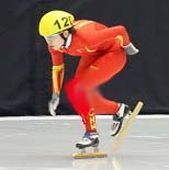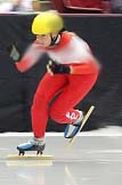The 3 Keys Checklist – Find the Key in the Basics First!By Susan Ellis, September 2007
|
Beware of those who stand aloof and greet each venture with reproof; the world would stop if things were run by men who say, "It can't be done." |
Almost all good things and almost all bad things in technique can be traced to what I call the 3 keys. If you have these three keys you have a much better shot at nailing most of the other things you need for speed. If they are not nailed down, a whole bunch of nasty things start to happen as a result of just one thing being off.

Many people go in search of extraneous corrections that are a direct result of one of the keys being off instead of finding the root of the problem. Solve the key first, and chances are you’ll solve a bunch of other things.
It is painful to listen to a coach telling a skater to stop pushing with the toe, without telling them the cause of the toe push. Or to hear a skater say “I keep falling backwards on the corner”, but not knowing what to correct to stop doing this.
FIND THE KEY IN THE BASICS FIRST!
The three most important keys to check for are:
1) Upper body position 2) Butt tuck 3) Ankle bend
1) Upper body position
This means having a compact belly to thigh position with a slightly rounded and relaxed back. Belly to thigh means that the lower part of your belly, below your belly button, is touching, or close to, the upper part of your thigh just below where it joins your torso. It also means having a slightly rounded and relaxed back, with the upper chest fairly close to the thigh. How close is a matter of body type, torso length, and flexibility. Some will skate with slightly higher chest than others and be fine with it, some will skate slightly lower and it works for them.
It is painful to listen to a coach telling a skater to stop pushing with the toe, without telling them the cause of the toe push. Or to hear a skater say “I keep falling backwards on the corner”, but not knowing what to correct to stop doing this.
FIND THE KEY IN THE BASICS FIRST!
The three most important keys to check for are:
1) Upper body position 2) Butt tuck 3) Ankle bend
1) Upper body position
This means having a compact belly to thigh position with a slightly rounded and relaxed back. Belly to thigh means that the lower part of your belly, below your belly button, is touching, or close to, the upper part of your thigh just below where it joins your torso. It also means having a slightly rounded and relaxed back, with the upper chest fairly close to the thigh. How close is a matter of body type, torso length, and flexibility. Some will skate with slightly higher chest than others and be fine with it, some will skate slightly lower and it works for them.

Common mistakes:
Upper chest or entire torso (belly to thigh angle) too high
Upper chest or entire torso (belly to thigh angle) too high
- keeps weight back towards heels
- shortens recovery, or recovery motion difficult
- trying for full recovery causes weight to rock back
- may cause ankle to be too bent on landing and then can’t bend any farther or landing open and ankle can’t bend any farther
- falling backwards on corner
- tension in upper and/or lower back, flat back
- skates land too close to each other (can’t thrust forward)

Upper chest or torso too low
2) Butt tuck
Your butt cheeks should be tucked under you with your cheek bones (and tail bone) pointed towards the ice and not sticking out mooning your mamma. Be careful in getting your belly to your thigh that you don’t lose your butt tuck.
- causes butt cheeks to stick out
- pressure goes to toes rather than ball
- poor ankle bend because butt is stuck out
- pushing backwards
- falling forwards on corner
- tension in lower back
2) Butt tuck
Your butt cheeks should be tucked under you with your cheek bones (and tail bone) pointed towards the ice and not sticking out mooning your mamma. Be careful in getting your belly to your thigh that you don’t lose your butt tuck.
 Out butt
Out butt
Common mistakes:
Out butt (cheeks stuck out)
Over tuck (too much butt tuck)
3) Ankle position
Straights – The ankle should be fairly open on landing (65-80 degrees) on the straight and closing to full ankle bend as you load your push. This means you will land on your heel and then close the ankle to bring the pressure to the ball of the foot.
Corners – you need to land mid-blade rather than heel because of centrifugal force, so this means landing with the ankle more closed than on the straights and then closing to full ankle bend.
Common mistakes:
Out butt (cheeks stuck out)
- pressure goes to toes rather than ball
- poor ankle bend
- pushing backwards
- falling forwards on corner
- tension in lower back
- shoulders too low
Over tuck (too much butt tuck)
- rocking backwards to heel on both straights and corner
- poor ankle bend
- chest comes up
3) Ankle position
Straights – The ankle should be fairly open on landing (65-80 degrees) on the straight and closing to full ankle bend as you load your push. This means you will land on your heel and then close the ankle to bring the pressure to the ball of the foot.
Corners – you need to land mid-blade rather than heel because of centrifugal force, so this means landing with the ankle more closed than on the straights and then closing to full ankle bend.
Common mistakes:
- Too closed on landing = no forward momentum in to next push. Check that your chest is not too high.
- Too open on landing – over reaching. Check that your chest is not too high.
- Ankle not closing at all. Check chest and butt tuck, then check recovery leg.
Once you have these 3 main keys the next two most important things to look at in terms of making corrections are the recovery leg and the arm swing.
Recovery leg
On the straights, the recovery leg should immediately relax and the thigh returns to a perfectly vertical position behind the gliding leg with the tip of the blade pointing directly at the ice and close to the ice.
Common mistakes:
Arm Swing
The arm swing should be loose and relaxed. The elbows should always stay close to the body on both the up swing and the back swing and should never point outward. On the up swing, the elbow relaxes as it passes by the body and the upper arm continues to swing forward to a point just past the thrusting knee. The forearm continues to swing upward, and very slightly across (midline of the body) to a point where the wrist is about in line with the front brim of the helmet. Except for the left arm on the corner, the arm never folds back in to touch either the body or come back towards the nose.
The hands should be relaxed as if you are cupping a tiny bird. The thumb is on top on the up swing and pointed down on the back swing, i.e.: palms always face inward.
One of the biggest problems we see in skating are rotations. After checking the upper body and butt tuck are all OK, then check the arm swing as a potential cause of rotations.
Common mistakes:
When assessing what is going wrong, find the things that are going right first, as you don’t want to lose them. Always check your 3 main keys first, then the recovery and arms, and chances are you are easily able to make the adjustments you need.
Recovery leg
On the straights, the recovery leg should immediately relax and the thigh returns to a perfectly vertical position behind the gliding leg with the tip of the blade pointing directly at the ice and close to the ice.
Common mistakes:
- Recovering from the side rather than back: This results in less ankle bend and therefore less forward momentum. Also compromises the ability to thrust the recovery thigh back to a belly to thigh position. Check the chest position to see if it is the cause of the short or side recovery.
- Swooping recovery: Leg sweeps too far back. Usually caused by the butt cheeks sticking out or the chest too low or a combination of both.
- Knees point out on recovery: First check the belly to thigh and upper body round and down. With your belly to your thigh it is harder to rotate your recovery thigh and knee outwards. Some skaters have good belly to thigh in the first part of the recovery but lose it in the thrust through as the chest comes up and/or the belly leaves the thigh. This almost always causes a rotation of either the torso or the recovery leg.
- Knees point in on recovery: Check the upper body position. Usually caused by rotation of the upper body. Also check arm swing. A more rare cause is simply trying to get too low with entire body.
Arm Swing
The arm swing should be loose and relaxed. The elbows should always stay close to the body on both the up swing and the back swing and should never point outward. On the up swing, the elbow relaxes as it passes by the body and the upper arm continues to swing forward to a point just past the thrusting knee. The forearm continues to swing upward, and very slightly across (midline of the body) to a point where the wrist is about in line with the front brim of the helmet. Except for the left arm on the corner, the arm never folds back in to touch either the body or come back towards the nose.
The hands should be relaxed as if you are cupping a tiny bird. The thumb is on top on the up swing and pointed down on the back swing, i.e.: palms always face inward.
One of the biggest problems we see in skating are rotations. After checking the upper body and butt tuck are all OK, then check the arm swing as a potential cause of rotations.
Common mistakes:
- No, or minimal swing – check arms are loose and relaxed with hands slightly open
- Stiff arm swing – again check relaxation
- Elbows pointed out throughout swing
- Elbows rolling back in under chest on upswing and thumb under nose
- Too much swing or too much cross body swing
- Cupping the bird with palms up or down rather than palms in
When assessing what is going wrong, find the things that are going right first, as you don’t want to lose them. Always check your 3 main keys first, then the recovery and arms, and chances are you are easily able to make the adjustments you need.

